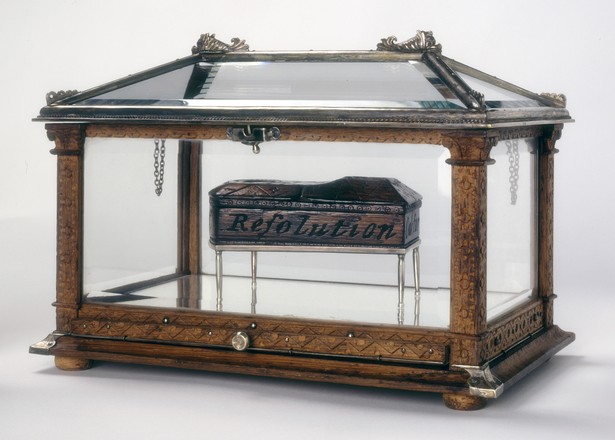
Coffin-shaped ditty box
1779
Carved wood inlaid with mother-of-pearl shell, silver stand
Bequest of Sir William Dixson, 1952
DR 2
Carved wood inlaid with mother-of-pearl shell, silver stand
Bequest of Sir William Dixson, 1952
DR 2
‘A labour of love’
Cook’s sudden, violent death caused profound shock and grief among his crew. During the homeward voyage, sailors on board HMS Resolution carved this tiny coffin-shaped ditty-box from a fragment of the ship’s timber. It holds a lock of Cook's hair and a watercolour sketch of his last moments alive.
On the ship’s return to England, the ditty-box was presented to Cook’s widow Elizabeth. It was then passed on to members of her family, along with the story of how it was made. The ditty-box eventually came into the possession of Thomas Hart, who in 1912 recorded the story in a written statement, which he placed in a sliding compartment in its base:
‘One week after Captain Cook’s murder his head was brought to the ship by a native chieftain the mutilated and mortified head the horrified ships company recognised their beloved Captain’s features. A few locks of hair were snipped off and the head swathed in linen was placed into a box hurriedly made by the Carpenter. This was heavily weighted and with … the tears of the crew consigned to the sea.
‘On the long homeward voyage … this box was made to preserve the tress of hair. It was a labour of love for each one to add his portion and naturally a coffin-shaped “diddy-box” suggested itself as being appropriate. One dug out the centre, two or three carved various parts, others beat out coins for the plates or ground the flaps into place to enclose and cover the hair and picture drawn by a crew member … Originally is also contained buttons, braid and tokens of or relating to Captain Cook. It was presented to Mrs Cook on arriving in England, where possibly the engraving was done or deepened.’


 Back to list
Back to list